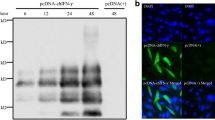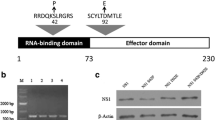Abstract
The non-structural protein 1 (NS1) of avian influenza virus was defined as one of the virulent factors. To understand the effect of NS1 protein of influenza virus H5N1 isolated in Thailand on type I (α/β) interferon (IFN) synthesis, five reverse genetic viruses were constructed and used as models. The viruses were generated using NS genomic segment from A/Peurto Rico/8/1934 (H1N1) and four avian influenza viruses isolated from the first outbreak in Thailand. All the viruses have the rest of the genome from A/Peurto Rico/8/1934 (H1N1). The constructed viruses were named (1) NS1 PR8/34, (2) NS1 wild type, (3) NS1 L15FD53G, (4) NS1 N171I and (5) NS1 E71K, respectively. The type I (α/β) IFN gene expression in control and infected primary chicken embryonic fibroblast cells were analyzed by quantitative polymerase chain reaction. The results show that the inhibition of IFN-β gene expression by NS1 wild type infected cells is stronger than NS1 N171I, NS1 E71K, NS1 PR8/34 and NS1 L15FD53G, respectively. The data suggest that the difference of amino acid sequence of NS1 protein contributes to the IFN-β antagonist. In contrast, the difference of the NS1 protein does not influence in the IFN-α antagonistic activity.


Similar content being viewed by others
References
Campitelli L, Ciccozzi M, Salemi M, Taglia F, Boros S, Donatelli I, et al. H5N1 influenza virus evolution: a comparison of different epidemics in birds and humans (1997–2004). J Gen Virol. 2006;87(Pt 4):955–60.
Geiss GK, Salvatore M, Tumpey TM, Carter VS, Wang X, Basler CF, et al. Cellular transcriptional profiling in influenza A virus-infected lung epithelial cells: the role of the nonstructural NS1 protein in the evasion of the host innate defense and its potential contribution to pandemic influenza. Proc Natl Acad Sci USA. 2002;99(16):10736–41.
Hale BG, Randall RE, Ortin J, Jackson D. The multifunctional NS1 protein of influenza A viruses. J Gen Virol. 2008;89(Pt 10):2359–76.
Hayman A, Comely S, Lackenby A, Murphy S, McCauley J, Goodbourn S, et al. Variation in the ability of human influenza A viruses to induce and inhibit the IFN-beta pathway. Virology. 2006;347(1):52–64.
Hoffmann E, Neumann G, Kawaoka Y, Hobom G, Webster RG. A DNA transfection system for generation of influenza A virus from eight plasmids. Proc Natl Acad Sci USA. 2000;97(11):6108–13.
Jia D, Rahbar R, Chan RW, Lee SM, Chan MC, Wang BX, et al. Influenza virus non-structural protein 1 (NS1) disrupts interferon signaling. PLoS ONE. 2010;5(11):e13927.
Jiao P, Tian G, Li Y, Deng G, Jiang Y, Liu C, et al. A single-amino-acid substitution in the NS1 protein changes the pathogenicity of H5N1 avian influenza viruses in mice. J Virol. 2008;82(3):1146–54.
Kochs G, Garcia-Sastre A, Martinez-Sobrido L. Multiple anti-interferon actions of the influenza A virus NS1 protein. J Virol. 2007;81(13):7011–21.
Korteweg C, Gu J. Pathology, molecular biology, and pathogenesis of avian influenza A (H5N1) infection in humans. Am J Pathol. 2008;172(5):1155–70.
Li Z, Jiang Y, Jiao P, Wang A, Zhao F, Tian G, et al. The NS1 gene contributes to the virulence of H5N1 avian influenza viruses. J Virol. 2006;80(22):11115–23.
Lin D, Lan J, Zhang Z. Structure and function of the NS1 protein of influenza A virus. Acta Biochim Biophys Sin (Shanghai). 2007;39(3):155–62.
Liniger M, Moulin HR, Sakoda Y, Ruggli N, Summerfield A. Highly pathogenic avian influenza virus H5N1 controls type I IFN induction in chicken macrophage HD-11 cells: a polygenic trait that involves NS1 and the polymerase complex. Virol J. 2012;9:7.
Livak KJ, Schmittgen TD. Analysis of relative gene expression data using real-time quantitative PCR and the 2(-Delta Delta C(T)) method. Methods. 2001;25(4):402–8.
Long JX, Peng DX, Liu YL, Wu YT, Liu XF. Virulence of H5N1 avian influenza virus enhanced by a 15-nucleotide deletion in the viral nonstructural gene. Virus Genes. 2008;36(3):471–8.
Marcus PI, Rojek JM, Sekellick MJ. Interferon induction and/or production and its suppression by influenza A viruses. J Virol. 2005;79(5):2880–90.
Marcus PI, Ngunjiri JM, Sekellick MJ, Wang L, Lee CW. In vitro analysis of virus particle subpopulations in candidate live-attenuated influenza vaccines distinguishes effective from ineffective vaccines. J Virol. 2010;84(21):10974–81.
Matrosovich M, Zhou N, Kawaoka Y, Webster R. The surface glycoproteins of H5 influenza viruses isolated from humans, chickens, and wild aquatic birds have distinguishable properties. J Virol. 1999;73(2):1146–55.
Matrosovich MN, Matrosovich TY, Gray T, Roberts NA, Klenk HD. Neuraminidase is important for the initiation of influenza virus infection in human airway epithelium. J Virol. 2004;78(22):12665–7.
Nemeroff ME, Barabino SM, Li Y, Keller W, Krug RM. Influenza virus NS1 protein interacts with the cellular 30 kDa subunit of CPSF and inhibits 3′end formation of cellular pre-mRNAs. Mol Cell. 1998;1(7):991–1000.
Ngunjiri JM, Mohni KN, Sekellick MJ, Schultz-Cherry S, Webster RG, Marcus PI. Lethal H5N1 influenza viruses are not resistant to interferon action in human, simian, porcine or chicken cells. Nat Med. 2012;18(10):1456–7.
Ngunjiri JM, Lee CW, Ali A, Marcus PI. Influenza virus interferon-inducing particle efficiency is reversed in avian and mammalian cells, and enhanced in cells co-infected with defective-interfering particles. J Interferon Cytokine Res. 2012;32(6):280–5.
Ngunjiri JM, Buchek GM, Mohni KN, Sekellick MJ, Marcus PI. Influenza virus subpopulations: exchange of lethal H5N1 virus NS for H1N1 virus NS triggers de novo generation of defective-interfering particles and enhances interferon-inducing particle efficiency. J Interferon Cytokine Res. 2013;33(3):99–107.
OIE. Manual of diagnostic tests and vaccines for terrestrial animals. 6th ed. Paris, France: OIE; 2008.
Pfaffl MW, Horgan GW, Dempfle L. Relative expression software tool (REST) for group-wise comparison and statistical analysis of relative expression results in real-time PCR. Nucleic Acids Res. 2002;30(9):e36.
Qiu Y, Nemeroff M, Krug RM. The influenza virus NS1 protein binds to a specific region in human U6 snRNA and inhibits U6-U2 and U6-U4 snRNA interactions during splicing. RNA. 1995;1(3):304–16.
Ramos I, Carnero E, Bernal-Rubio D, Seibert CW, Westera L, Garcia-Sastre A, et al. Contribution of double-stranded RNA and CPSF30 binding domains of influenza virus NS1 to the inhibition of type I interferon production and activation of human dendritic cells. J Virol. 2013;87(5):2430–40.
Seo SH, Hoffmann E, Webster RG. Lethal H5N1 influenza viruses escape host anti-viral cytokine responses. Nat Med. 2002;8(9):950–4.
Seo SH, Hoffmann E, Webster RG. The NS1 gene of H5N1 influenza viruses circumvents the host anti-viral cytokine responses. Virus Res. 2004;103(1–2):107–13.
Suwannakhon N, Pookorn S, Sanguansermsri D, Chamnanpood C, Chamnanpood P, Wongvilairat R, et al. Genetic characterization of nonstructural genes of H5N1 avian influenza viruses isolated in Thailand in 2004–2005. Southeast Asian J Trop Med Public Health. 2008;39(5):837–47.
Twu KY, Noah DL, Rao P, Kuo RL, Krug RM. The CPSF30 binding site on the NS1A protein of influenza A virus is a potential antiviral target. J Virol. 2006;80(8):3957–65.
Wright PF, Neumann G, Kawaoka Y. Orthomyxoviruses. In: Knipe DM, Howley PM, editors. Fields virology. Philadelphia: Lippincott Williams and Wilkins; 2007. p. 1691–740.
Acknowledgments
Faculty of Medical science and Faculty of Medicine, Naresuan University, Thailand provided laboratory instruments. Veterinary Research and Development Centre of Northern Lower Region, Phitsanulok, Thailand provided the viral specimen and biosafety level 3 facilities. The pHW2000 plasmids containing the cDNA of each gene of the A/Puerto Rico/8/34 (H1N1) were given from Dr. Robert G. Webster and Dr. Erich Hoffmann of St. Jude Children Research Hospital, Memphis, USA. We would like to thank Prof. Dr. Gavin Reynolds and Dr. Ian Fraser for his suggestion of the manuscript.
Author information
Authors and Affiliations
Corresponding author
Rights and permissions
About this article
Cite this article
Thepmalee, C., Sanguansermsri, P., Suwanankhon, N. et al. Changes in the NS1 gene of avian influenza viruses isolated in Thailand affect expression of type I interferon in primary chicken embryonic fibroblast cells. Indian J. Virol. 24, 365–372 (2013). https://doi.org/10.1007/s13337-013-0158-8
Received:
Accepted:
Published:
Issue Date:
DOI: https://doi.org/10.1007/s13337-013-0158-8




